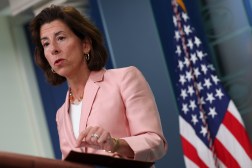Federal Chief Information Officer Steven VanRoekel and Chief Technology Officer Todd Park officially unveiled the Digital Management Strategy on Wednesday at TechCrunch Disrupt in New York that aims to institutionalize and standardize the mobile evolution in the federal government.
“We’re living in an increasingly mobile world, and it is critical that the federal government keep up with the way the American people do business. Already, families can use government apps to check the wait time at the airport, get access to critical veteran services, and check the status of their tax return. Today’s directive will accelerate our drive to make key services easily accessible to more Americans than ever,” VanRoekel said.
A memorandum from President Obama accompanied the release of the strategy, giving federal agencies one year to comply with the regulations put forth in the strategy and 90 days to create a website, located at www.[agency].gov/digitalstrategy, that will publicly report progress in meeting the requirements of the strategy in a machine-readable format.
“Americans deserve a government that works for them anytime, anywhere, and on any device,” Obama said. “By making important services accessible from your phone and sharing government data with entrepreneurs, we are giving hard-working families and businesses tools that will help them succeed.”
The Digital Government Strategy sets out to accomplish three goals:
• Enable the American people and an increasingly mobile workforce to access high-quality digital government information and services anywhere, anytime, on any device: Operationalizing an information-centric model, we can architect our systems for interoperability and openness, modernize our content publication model, and deliver better, device-agnostic digital services at a lower cost
• Ensure that as the government adjusts to this new digital world, we seize the opportunity to procure and manage devices, applications, and data in smart, secure and affordable ways: Learning from the previous transition of moving information and services online, we now have an opportunity to break free from the inefficient, costly, and fragmented practices of the past, build a sound governance structure for digital services, and do mobile “right” from the beginning
• Unlock the power of government data to spur innovation across our Nation and improve the quality of services for the American people: We must enable the public, entrepreneurs, and our own government programs to better lever- age the rich wealth of federal data to pour into applications and services by ensuring that data is open and machine-readable by default
The strategy lays out 29 different goals for agencies with deadlines spread out over the next year. One of those goals including the creation of a FedRAMP for mobile and a new innovation center run out of the General Services Administration’s Office of Citizen Services and Innovative Technology.
The mobile version FedRAMP will be led by the Department of Defense, the Department of Homeland Security and the National Institute of Standards of Technology.
The three agencies will develop a mobile/digital security platform over the next 12 months.
The strategy also outlines a plan for delivering better citizen services where agencies will be instructed to execute on a three-layer strategic approach that aims to help government “innovate with less.”
The three “layers” — information, production, presentation — comprise a strategy that decouples content from aesthetics and helps agencies focus on data, content management systems and allows them to more efficiently publish information across multiple platforms, such as websites, mobile devices or application programming interfaces.
The roadmap is divided into four components — “Information-Centric,” “Shared First,” “Customer-Centric,” “Security and Privacy.”
“Building for the future requires us to think beyond programmatic lines,” the document states. “To keep up with the pace of change in technology, we need to securely architect our systems for interoperability and openness from conception. We need to have common standards and more rapidly share the lessons learned by early adopters. We need to produce better content and data, and present it through multiple channels in a program and device-agnostic way. We need to adopt a coordinated approach to ensure privacy and security in a digital age.”
In conjunction with the launch of the strategy, Park is launching a new Presidential Innovation Fellows program.
The program will bring in top innovators from outside government for focused “tours of duty” to work with federal innovators on creative new projects. Among the projects that the fellows will take on are ones to make consumer-friendly government information about health, education, energy, safety and personal finance more accessible to all Americans.
“The release of government weather and GPS data has already led to countless entrepreneurial innovations, which have made life easier for America’s families while also creating multi-billion-dollar industries and generating jobs,” Park said. “The initiatives we’re launching today will make government data resources even more accessible to the public and to entrepreneurs who can turn these data into services that can help Americans find the best doctor for their family, choose the college that offers them the most value for their money, save money on their energy bills through smarter shopping, and much more.”
The Open Data Initiatives program aims speed and expand the release of government data in machine-readable form in realms ranging from healthcare to education to energy to public safety, and will actively stimulate the creation of new apps and services by entrepreneurs.
Both VanRoekel and Park are scheduled to speak at The U.S. Innovation Summit presented by FedScoop on June 20.




